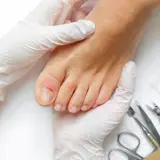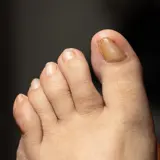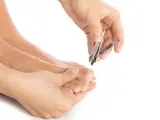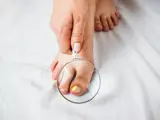Shoes have a massive influence on getting ingrown toenails. Shoes that crowd your feet and cause your toenails to be scrunched for long periods can cause the nails to begin growing improperly. Tight shoes are sometimes unavoidable, but wearing well-fitting shoes can play a role in causing ingrown toenails.

Common solutions for common issues
Ingrown toenails are very common. Typically this condition is a simple nuisance that can cause obnoxious pain but never becomes severe. On rare occasions and if not treated properly, this simple nuisance can turn into a disabling problem requiring hospitalization.
An ingrown toenail occurs when the corner of your nail begins to grow at the wrong angle. It begins to grow down into the skin rather than on top. Ingrown toenails are most common on big toes, but they can happen on any toe. Generally, this is caused by cutting your toenail incorrectly or too short.
In general, there is no treatment for ingrown toenails required. On some occasions, though, it can escalate and become infected. At Teton Foot and Ankle Center, we can do a simple 3-minute procedure to help treat the ingrown toenail when this happens.

Cause of Ingrown Toenails
There are a lot of causes of ingrown toenails. Some causes of ingrown toenails can be helped, and others are out of your control.
Symptoms of Ingrown Toenails

Painful to touch
While the causes of ingrown toenails can differ, the one thing that every ingrown toenail has in common… PAIN. This pain is typically around the toenail and can make it hurt to walk, wear shoes and socks, and even shower.
Generally, another symptom is redness and slight swelling of the skin around the toenail. The skin gets inflamed because it is getting pressed by the nail, and this causes severe (and annoying) pain.
In severe cases, the ingrown toenail can become infected. Typically this looks like your toe being inflamed, red, and sometimes pus can surround the ingrown nail. In most cases, the infection is mild if it is there, and these symptoms get better pretty quickly. In the rare few, this condition escalates and can become much worse.

When to see your doctor
If it continues to get worse, you should see your doctor to treat your ingrown toenail. If your pain and discomfort become severe and limits your ability to walk or do your day-to-day activities, it is probably time to see your doctor. Also, if the infection begins spreading, you should make an appointment with your doctor.
If you have pre-existing health complications that result in poor blood circulation to your feet, you should see your doctor sooner. Conditions including (but not limited to) diabetes and others are important to be aware of. If ingrown toenails are left untreated, they can turn severe and cause infections.
At Home
Treatment of Ingrown Toenails
Generally, treatment for ingrown toenails can be done at home. For more severe cases, treatment involves simply trimming out the edge of the ingrown nail during an outpatient procedure.
With some patience and keeping the ingrown nail clean, it will resolve itself most of the time. If more treatment is necessary, you can do a couple of things.

Doctor Treatment
At Teton Foot and Ankle Center in Idaho Falls, we offer numerous treatment options for ingrown toenails. Most doctors may be able to do something for your ingrown toenail, but as podiatrists (foot and ankle doctors), we offer more advanced treatment to help you treat the ingrown toenail.
If it is a severe ingrown toenail, we may need to perform a simple 3-minute procedure that removes the edge of the nail and apply a specialized chemical to that area. This chemical will permanently stop the edge of the nail from returning. While this sounds extreme, it really isn’t. It will drastically help your ingrown toenail and prevent them from happening in the future while also keeping your nail looking natural.
If you are looking for treatment for ingrown toenails in Idaho Falls, give us a call today.
Preventing Ingrown Toenails
There are some things that you can do to help prevent ingrown toenails from occurring. Understanding the causes of ingrown toenails can also help you know how to prevent them from occurring.
When cutting your toenails, make sure you cut them straight across. You want to ensure your toenails are kept at a decent length. Not too long, but also not too short. It can be tempting to try and curve the cut of your toenail, but it is best to cut it straight across. If you cut them at a curve, the corners are more likely to get caught on your skin and create an ingrown toenail.
Sometimes wearing tight shoes can not be avoided. Shoes like rock climbing shoes are tight, but you need to wear them when rock climbing. Even ski and snowboard boots can be a little bit tighter. When possible, though, you should try and wear shoes that fit you properly and don’t squish your toes and toenails together.
Shoes that are too tight can cause toenails that were cut too short to grow at a funky angle and ultimately become ingrown.
Finally, it is important to be aware. Staying on top of it can help decrease the risk of infection and increased pain. If you notice an ingrown toenail and it isn’t getting better, make an appointment for ingrown toenail treatment in our office in Idaho Falls.
Get in touch!
Call our office if you have any questions about what we do or to schedule an appointment.
